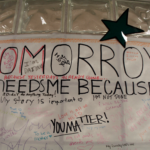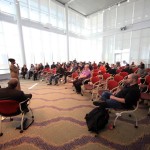Student Government Fails Again! From Snafu to Abysmal- SGA Still Haven’t Gotten the Elections Right
The Student Government Association’s recent election for next year’s officers was completed April 23 and 24 under the radar of the average student on campus.
This year’s election resulted in six positions being filled, and only the president position had more than one candidate running. Brian Nwafor won the president position over Keith Durao, with 109 votes cast.
Those 109 votes are not a good representation of the 7,500 students that are taking for-credit courses on campus, the students paying the Student Activities Fund. The purpose of the SGA is to govern this fund. The proposed budget for next year is approximately $80,000. This money is used for programming of events like the recent Spring Fling, bus trips, and funds for clubs to operate. The students’ voice in where the money goes is amplified through the elections in the spring.
In the interest of full disclosure, I was involved in moderating the debate on campus between the candidates for president, but did not include myself on any decisions by the SGA elections committee.
The elections committee is made up of students who have the most influence on how the election is organized. Prior to declaring his intent to campaign for Student Advisory Council Representative to the Board of Regents, which oversees most of Connecticut’s colleges, SGA Vice-President Josh Quintana was the chair and was influential in organizing much of the election process.
This year did have a hiccup with elections due to a constitution revision that changed around the executive board positions and had to be approved during the SGA general meeting in early April. This held up plans and allowed for only approximately two weeks of campaigning after postponing the election to the end of April. The elections committee really needed to have postponed the election into May to give enough time for quality campaigning.
Time for campaigning was a key factor for the candidates as well. Since Nwafor spent so much time on campus with his SGA duties, and Durao had to be at his internship at the capitol for 50 percent of the campaigning period, it seemed that Nwafor already had an unfair advantage.
Many students also said they felt that the campaigning wasn’t up to par, and that more should have been done.
“How am I supposed to be motivated to vote,” said student Rosemary Hahn, “if there isn’t even a picture of the candidate or any information about them.”
Some students said they had heard about the election, including Glen Nichols, who is involved with the Administrative Professionals Club.
“Brian [Nwafor] came around and introduced himself,” he said. “That’s how I knew to vote for Brian.”
These student’s responses made me think about exactly how many on campus really heard about the election and just had apathy for the process or would be willing to vote but didn’t know about what was going on.
I took an informal survey of 50 students on campus May 2, trying to get a wide variety of perspectives. I asked students in the courtyard, the Cougar Cafe, the Tower Cafe, the Lowe building, and in the halls connecting the buildings. I asked students who were involved in clubs, students who are not, and a couple of students who knew SGA student leaders. Brian McPherson and Sabatino Fillion, student leaders on campus, helped me with the survey process.
The question I asked was “Did you vote or hear about the SGA election?” Two said they had, eight had heard but not voted, and 40 said they had not heard about the election at all. I planned to ask far more than 50 students, but I was already beginning to see a growing trend as the majority of students had no idea what I was talking about when I brought up SGA or SGA elections.
So when tallying the results, about 80 percent of the sample was unaware, but many commented on how they would have liked to have been involved.
As I walked around collecting the survey results a few students chose to make their voices heard. One of these was current SGA Webmaster Nirav Shah.
“The SGA election was so fricken’ hidden,” he said, “no fliers were really seen on campus.” Though the fliers are partly the responsibility of the candidate to make themselves known, the shortened campaign time hindered their ability to create and distribute.
Talking to Dean of Student Affairs Duncan Harris, he introduced an idea that next school year the elections committee convene around January to begin thinking and planning events to lead up to the elections. Also, he suggested that the committee give updates to students attending the SGA general meetings, which are held at least twice a month. This, Dean Harris said, could generate some interest in leaders to begin thinking of their campaigns, as well as getting students ready and excited about voting.
I think the candidates should be given a certain allotment to help them with their campaign, like 50 complimentary flier copies from the SGA’s new copy machine. The SGA may also be able to help candidates with ideas for publicizing (as long as they gave equal help to all candidates).
T.J. Barber, director of Student Activities, said “the ideal is for everyone on campus to be involved, [debates] broadcasted from every TV in the school.”
Though Barber is quick to tell the students what the ideal is, there are still those that I talked to who were barred from voting due to not knowing the process. One student said she was told last year that she needed to have an MCC photo ID to vote. She didn’t have one this year so she didn’t even try to, though she had heard about the elections; another student said that he was told to vote but not where to vote.
The biggest avenue the SGA has to promote the election is through the debates held between candidates. Last year three debates were held, one with all the candidates and two that were just between the presidential candidates, all set around campus during times when there is a lot of foot traffic to get a wide audience.
Approximately 600 students voted in last year’s election. Some of that was due to the candidates having enough campaign time and the numerous debates that were held, but also because of some conduct issues that aroused allowing rumors to spread through campus like wild-fire.
Though I don’t condone the drama from last year, many students did become aware of the election. The candidates also set out to talk to as many students as they could, even having flier wars on the bulletin boards around campus. The administration has seemed to overly correct the extreme from last year, facilitating the opposite extreme, voter suppression; hopefully next year a balanced middle ground may be found.
The problem with this year’s debate is that there was only one, and it was during an SGA general meeting where leaders were also discussing highly controversial topics brought on by the passing of the new SGA Constitution. So only those who were at the meeting were exposed to the debate. I counted: of those 19 students who were left when the debate started, two took off during the debate.
Although the debate was held during a public meeting, it was outside of the environment of a typical student.
“There was a decent representation of club officers, but not typical students,” said Durao, who ran for SGA president.
When asked why the SGA opted to host the debate during the SGA meeting rather than in a more student populated area, outgoing SGA president Jon Colon said it was an “executive decision.” The other presidential candidate, Nwafor, who won the election, said he thought the debate “could have been a bigger venue for students to come in and hear from the candidates.”
When it comes down to it, the students should evaluate this election and come to terms with the fact that 109 votes were cast out of a possible 7,500 and ask themselves whether or not they are okay with the small representation. Personally I would call into question the validity of SGA president-elect Nwafor’s win, since only 1.4 percent of the student population even knew about it.







